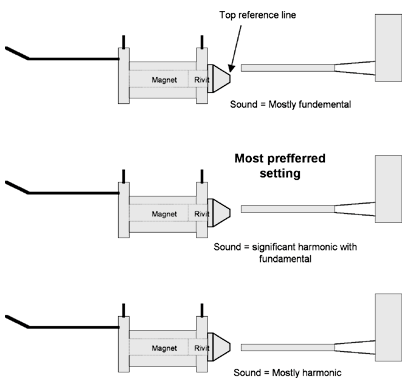Steve's Corner - Ideal Tine Settings
The settings that most of the performers that I came into contact with requested were as follows. Generally the "mostly fundamental" covered the first 15 notes, the "most preferred" covered the rest of the notes with rubber tips, and the "mostly fundamental" setting covered the wood with rubber shrink-wrapping tips. The horizontal gap between the end of the tine and the point of the pickup was 1/16" for the wood tips, 1/32" for the mid-range notes and 1/16" for the bass notes.

I have noticed the comments about how long it takes to adjust a Rhodes. Adjusting by sound only can fatigue the ears and fool the adjuster. So, using the above settings (top and middle settings) as reference points, I visually make all of my first and second adjustments, comparing the bottom of the tine to the top reference line. The lower your viewing angle for the tone settings, the more accurate the settings will be. I look straight down for the pickup volume settings, then I make the final adjustment by ear. Afterward, I check and set the pitch using a strobe tuner. This usually takes me less than one hour.
More Info
- Chapter 2: The RHODES Modular Action
- Chapter 4: Dimensional Standards and Adjustments
- Chapter 8: Early Design RHODES Pianos - Action (Prior to 1975)
- Chapter 10: Early Design RHODES Pianos - Dimensional Standards and Adjustments
